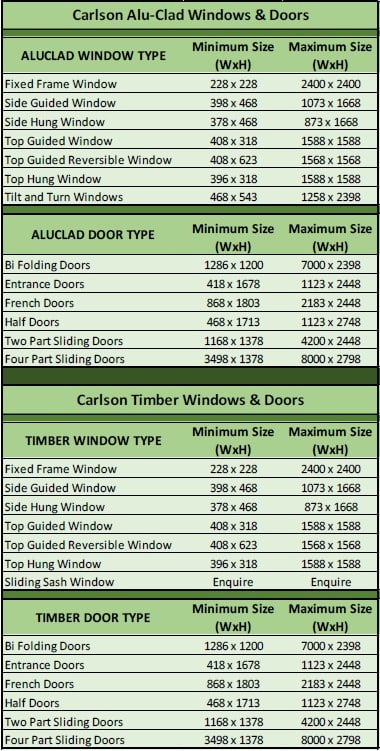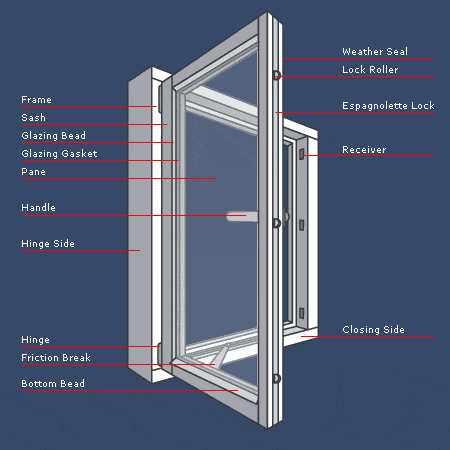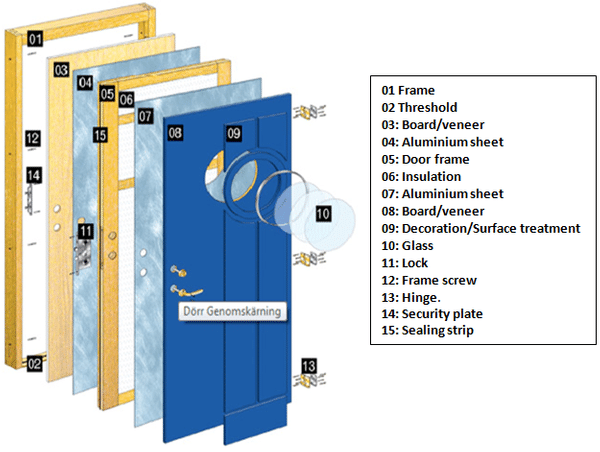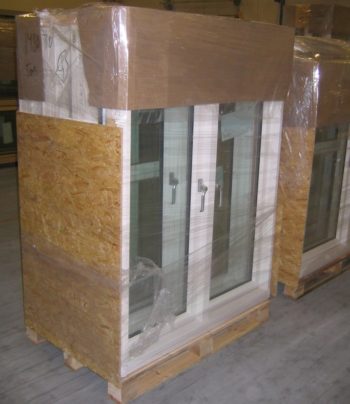TECHNICAL INFORMATION
Our Technical Information resource center helps you find technical documents for Carlson window and door products. Select your product below to download the drawings you require.
Please contact us for further support.
Other Technical Information
All of our Products are custom made to your exact specifications. The table below shows the minimum and maximum sizes that our Windows and Doors can be ordered in.
Please contact us for further information.
How Carlson Doors Are Constructed
Carlson’s exterior doors have many safety features to protect your home, for example, safety hinges with a mechanism that prevents your door from being lifted out of its frame. In addition, the hinges are secured to the frame with a metal mounting plate.
They also have a security unit, which protects against attempts to forcibly open the lock. The lock is equipped with a hook bolt that connects the door with the door frame and makes it virtually impossible to break apart the door and frame. Most Carlson exterior doors have three hinges.
01 Frame: The frame is made of solid pine and the dimensions are 40 x 105 mm. Teak doors are teak stained or solid framed, oak doors have a solid oak frame.
02 Threshold: Thresholds made of hardwoods normally have a protective aluminum strip. The profile of a threshold complies to disability standards where applicable.
03: Board/veneer: The inside and the outside of the door are covered with a moisture-resistant HDF board or glued veneer if the door is oak, pine or teak.
04: Aluminum sheet: The inner and outer layers of the door have a moisture repellant and stabilizing aluminum sheet which is 0.5 mm thick.
05: Door frame: The door frame is made of solid pine or oak.
06: Insulation: Environmentally-friendly polystyrene foam insulation. Fire doors are insulated using rock wool.
07 See point 4.
08 See point 3.
09 Decoration/Surface treatment: Decoration using sheet, strips and profiling on the outside of the door. Several surface treatment materials are available, for example, paint, teak or pine.
10 Glass: Mounting of a triple pane insulating window unit. The panes are available in several styles.
11: Lock: Most exterior doors are supplied with security classified locks which comply to relevant standards.
12: Frame screw: Pre-drilled frame to accommodate frame screws.
13: Hinge: Adjustable inserted barrel hinges with rear edge security. The hinge is secured in the frame with a fitting plate.
14 Security plate: Security plate with adjusting screws and a manually adjustable cover plate.
15 Sealing strip: Sealing strip made from long lasting rubber.
DOOR DIMENSIONS
The size of a door is always stated in module (M) size. This measurement is not the exact size of the door frame. It is the size of the opening in the wall where the door will be placed. For a door with module size 9 x 21 (width by height), you will need an opening in the wall of at least 900 x 2100 mm. The actual exterior door frame dimensions are 10 mm smaller in width and height in order to leave room for insulating materials and adjustment. The size of a module can also be expressed as including insulation and mounting fittings.
MEASURING FOR AN EXTERIOR DOOR
When replacing an exterior door, it is normal practice to replace both the door and the frame. The size of the door should be related to the size of the opening in the wall. It is not enough to measure the size of the door only. Contact your builder/carpenter if you are unsure. For an accurate measurement of the door you will need to remove strips and insulation around the frame of your old door. Measure the opening in the wall. Subtract 20 mm from the width and height of your dimensions. In this way, you get the maximum width and height your new door unit can have. Choose a suitable new door module.
RIGHT OR LEFT HANG?
When looking from the outside, decide if your door should be right or left hung.
We will notify you when to expect your Windows and Door delivery. Your order will then be delivered by truck on a pallet, which will be shrink–wrapped for transportation purposes. If you have questions about your delivery, please contact us.
Your delivery will take place as close to the time of fitting as possible. Whilst being stored on site, windows and doors are at a high risk of damage.
Below please find some guidelines in relation to the delivery and storage of Carlson windows & doors.
- The unloading and handling of windows and doors must be conducted in a safe and careful manner so as not to damage the window frame or glazing.
- We strongly recommend that windows and doors are stored indoors and vertical where ever possible on a level flat surface. Every effort should be taken to prevent the units from falling over.
- Always allow free air circulation around window and door storage. Never allow moisture and condensation to accumulate.
- Avoid warping by storing and distributing weight evenly on timber battens
- If it is necessary to store windows outside, this should be for the minimum time possible and protection should be provided from the elements.
Please Contact Us for any queries you might have about Window & Door deliveries.
After you have purchased your new Carlson Timber or Alu Clad windows & doors you can relax knowing that you have safely invested in durable, high quality products that will last a lifetime. Our products are designed to provide complete protection and are specially designed and built to survive in the harsh Scandinavian climate and come with both Product Warranties and Supplier Guarantees.
We have compiled some guidelines to help you look after and care for your new Carlson windows & doors
GENERAL GUIDELINES
- With Alu-Clad windows & doors the external surfaces are pretty much maintenance free and can be wiped down with a damp cloth as necessary
- Check the surface of windows & doors regularly, in particular, all timber units, so that any damage can be detected and repaired as quickly as possible. Vertical mouldings, on timber windows and doors, can become damaged, especially by the Ultraviolet rays of the sun and require more frequent maintenance than other surface areas
- Rubber Seals – A light dusting of talcum powder is good for stopping rubber weather seals from getting sticky
- Resin – Wood is a living material, because of this, droplets of resin may seep out onto the wood finish even after being treated. Some discolouring, primarily with light colours. This resin penetration can be removed carefully, by using mineral spirits
- Treating – All our windows & doors have been factory treated with a water-based wood preservative to protect against rot and fungal decay and have received a full factory finish coating. Periodically, recoat your windows & doors as needed using the correct type of stain or paint. Before recoating thoroughly clean the window or door surface with a mild detergent (not washing up liquid). Scrape away any peeling paint or stain and sand lightly with sandpaper, cleaning away any dust and apply a basecoat (if appropriate). When dry, lightly sand with fine sandpaper, brush away the dust and apply the first layer of paint or stain – repeat this step as appropriate and as per manufacturer’s instructions. Do not paint over moving hardware, rubber glazing seals, weather stripping or DVC Sticker. Do not close operating sashes or panels until completely dry. Surface treatments should be carried out when the most exposed parts of your windows or doors show signs of wear
- Lubrication – all Ironmongery to include hinges, handles and rivet joints as well any espagnolette locks, slide bars, roller bolts, slots, lock or bar lock should be lubricated as needed or at least once a year with an all-purpose oil. On Sashes fitted with Friction Brakes and /or concealed side swing and fully reversible hardware and mountings, it is important to keep the slide rails clean and free of excessive oil and paint
- Paint or Stain should not be applied to weather strips, glazing or hardware as this will cause damage as it goes hard, brittle and eventually become no longer fit for purpose
- Cleaning – use plenty of water the first time you wash your windows & doors after finishing your project. Remove window stickers using a sponge and hot water. Remove any leftover glue or silicone with solvent remover. After washing your windows & doors, be sure to dry off the sash and frames with a dry cloth. IMPORTANT: Never use gasoline, paint thinners or solvents that contain ammonia on painted or stained surfaces.
- Ventilation/Condensation – as homes are increasingly well insulated with less air flow, good ventilation has become more and more important. Whenever there is excess humidity in a home, it manifests itself in the form of condensation on the coldest area – which is normally the glass of windows & doors. To avoid this your home needs to be ventilated properly, habitable rooms should be ventilated a couple of times a day, never block or close vents. In the kitchen open the vents fully and turn extractor fan to maximum speed when cooking, put lids on pans during cooking to limit the amount of moisture entering the kitchen, vent well during and after cooking. In bathrooms never block or close vents or extractor fans, vent well after showering/bathing. If you are drying clothes indoors ensure there is adequate ventilation to allow the excess moisture escape.
Things to remember
- New/Refurbished homes are normally more insulated that older homes, increasing the need for ventilation to avoid condensation
- A new or renovated home needs more ventilation in its first year than an older home, as moisture in the walls is released
- Adults exhale about 2 litres of water every day
- Moisture problems increase as the room temperature decreases
- On calm days the sun can provide more free heat than is lost through normal ventilation.
If you have any further questions on maintenance, or would like more advice on Carlson windows and doors, please do not hesitate to contact us.
Looking for advice? Talk to our support team






